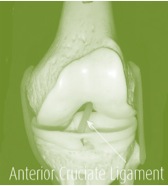Women may be at Higher Risk of Knee Arthritis after ACL Reconstruction

The knee, like any human joint, is a complex dance of stability and precisely controlled movement. The ACL ligament is a taut band that stabilizes the knee in a front-back direction and contributes to this finely tuned movement. When our patients have a completely snapped and retracted ACL tear (like a snapped rubber band), we often advise our patients to get it surgically reconstructed, as we believe that the added stability will protect the joint. Having said that, if the ACL is only partially torn or has significant fibers left, we often recommend needle based stem cell therapy treatments or other therapies to try and biologically augment the fibers that are left. The reason we don’t like our patients getting a partially torn ACL removed and replaced, is that despite reconstruction of the knee ACL, and the prolonged ACL surgery recovery, the knee isn’t and won’t ever be completely normal. A recent study which looked at a sophisticated analysis of walking patterns in patients with ACL surgical reconstruction supports this concept. Women who had knee ACL surgery had a tendency to shift their knee inward (adduction) during walking, which the study authors believed could lead to a higher rate of knee arthritis. Men didn’t have this same problem with walking after a knee ACL surgery. This is consistent with another study which found general biomechanical problems for patients with reconstructed ACL’s. The upshot? Be cautious about getting your ACL surgically replaced if the fibers are still intact. How do you know which type of ACL tear you have? Most patients we talk to aren’t sure whether their ACL is completely torn and gone or only partially torn, as surgeons will often recommend that either type of ACL tear get replaced with a new knee ACL ligament. As a result, reading your MRI report for keywords may help. For example, terms like “retracted” often mean the ACL has snapped like a broken rubber band (the type that needs surgical ACL replacement), whereas terms like “complete tear” without a discussion of how the ACL is “retracted” may still mean that there are intact fibers that can be treated with injection. The term “partial tear” almost always means that the ACL can be treated with injection techniques. As a clinic, we’ve pioneered new injection techniques to be able to accurately place various medications and stem cells into a partially torn and non-retracted knee ACL ligament.

If you have questions or comments about this blog post, please email us at [email protected]
NOTE: This blog post provides general information to help the reader better understand regenerative medicine, musculoskeletal health, and related subjects. All content provided in this blog, website, or any linked materials, including text, graphics, images, patient profiles, outcomes, and information, are not intended and should not be considered or used as a substitute for medical advice, diagnosis, or treatment. Please always consult with a professional and certified healthcare provider to discuss if a treatment is right for you.
